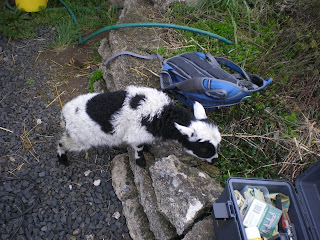I am so exited each day! Today my delight was to visit Tracy on McTavish farm. The task of the day was to sheer a mama who was pregnant with four little lambs and thus was not sheered with the others. A second mama of only one baby was also in need of some touch-ups.
The sheep with the large litter (which is evidently common with Fin breeds), rejected the runt, Rikki, and kept the other three to fight for her two teats. Here is baby number four (Rikki) who has been bottle-fed for these couple weeks of life and even started out in the house with a diaper, though she now lives out in the barn with a pen and heat lamp all to her self to keep away from the other mama's bullying. The other three babies are named Atom, Susi, and Tsunami. Can you guess what day in recent history they were born on?
Tracy is the only farmer I have met so far who sheers her own sheep. She has been farming for about ten years, and started sheering in the last two since her sheerer retired. This provided me with a much better opportunity for a good look at the process. Because she sheers her own sheep, she can do a few a day rather than all at once, which seems to be less stressful on everyone.
A neighbor came along so I was able to get her to take our picture. Usually it is very hard to get good pictures while working and impossible to be in them.
We started with the smaller sheep who only needed a touch-up. Tracy caught her in the barn where all the mama and baby sheep were being kept. We put a halter and lead on her and she became pretty cooperative and calm. Normally Tracy sheers the sheep in the usual manner of laying them on the ground and holding them in various positions with her legs, but that requires a 24hr fast for the sheep which didn't seem safe for the mother of three (plus one), so today we used the stand. The first ewe was lead to the stand where Tracy and I each grabbed under a front leg and got the front half of the lady on to the stand, then repeated for the reluctant back half of her. Fortunately, she is a small sheep so it wan't too bad. Her head was put into a metal guide and a chain was clipped around the back of her neck. One of us stayed on each side of her to keep her from falling off the stand. Tracy started with a line straight down the ewe's back to divide the fleece, then worked her way down. Before unclipping the sheep, Tracy trimmed the nails on each foot and some touch-ups were done with the giant scissor-like sheers.
Because the sheep was being held by her head and neck, we couldn't reach those parts to sheer while on the stand. We untied her and let her step down, then wrestled to safely sheer her neck. All of this fleece was only touch-ups, not long enough for spinning, so it was collected to be put in the compost pile for a couple of years. When we were through, the sheep was very happy to be reunited with her baby and set free.
Our next guest to the stand was the big mama. This ewe was a mix of a couple different breeds, and two to three times the size of the other sheep on Tracy's farm. She also came to the farm incredibly skiddish and was still not fond of being put in the halter. For this girl, Tracy got out an extra piece of fencing to use as a hand-held wall. We worked until we finally got her cornered between me, Tracy's fence, and two walls. With the mama ewe pinned to the wall, Tracy was able to get the harness and leash on. I held the ewe by the lead as Tracy released all the other sheep back out to the pasture.
Though this Ewe was significantly larger, she was also highly food motivated, so we took a bucket of pellets and put them on the far end of the stand, then hoisted her legs up on to the platform. From there she was able to scramble up with little help from us, and by moving the bucket of pellets, we were easily able to get her head properly aligned. I held her hips with one hand and gave her periodic handfuls of pellets to keep her subdued while Tracy sheered. Under her thick coat we could see that she was thin with a messy back end and bursting udder from having four and feeding three babies. Tracy was extra careful around the udders while trimming. This time we tried something different to sheer the ewe's head and neck. We untied her from the stand but left her on it with me holding her and kept her distracted with pellets while Tracy clipped away. We rolled up and bagged most of her wool for Tracy to use, though because we were sheering a standing sheep, the fleece was not intact and so won't be sold.
In the Shetland islands before shearers, and even after shearers came along, the people waited until the spring and then would tie up the sheep and gradually pluck out all the fiber. They felt that this was the best way to get the softest fiber and is loose and comes out easily.
Before I left, Tracy also showed me her various felting projects as well as the beautiful spinning wheels her husband is learning to make.



No comments:
Post a Comment